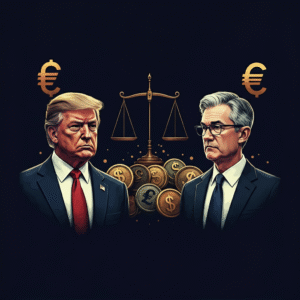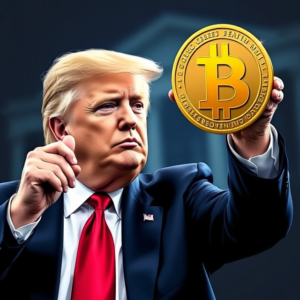In November 2025, global markets faced a major shock after President Donald Trump announced a new wave of tariffs on Chinese imports, targeting key industries like technology, energy, and manufacturing.
The sudden move triggered panic across financial markets, as investors feared a new round of trade tensions between the world’s two largest economies. Stock markets dipped sharply, and the crypto market followed with high volatility — Bitcoin saw a quick drop as traders rushed to manage risk and secure profits. However, some long-term investors believed this political uncertainty could actually strengthen Bitcoin’s value as a global, independent asset.
Why This Trade Move Matters for Crypto and Global Finance
Trump’s tariff escalation is more than just a trade policy — it reshapes how global finance and crypto markets interact. When tariffs increase, international trade slows and investor confidence weakens, pushing people away from risky assets like cryptocurrencies. Yet, these same conditions also make Bitcoin more attractive as a hedge against government control, inflation, and currency instability. In short, while Trump’s tariff decision brought short-term panic and market pressure, it also reminded investors of the long-term importance of decentralized assets in an unpredictable global economy.
What Happened: The Trade Shock & Immediate Crypto Response
Details of Trump’s 100% Tariff Announcement on China (Oct 2025)
In October 2025, President Donald Trump announced a sweeping 100% tariff on Chinese imports, targeting sectors like electronics, solar panels, and electric vehicles. The move was part of his “America First” trade agenda, aimed at reducing U.S. dependence on China. However, the sudden and aggressive nature of the decision caught global markets off guard. Investors feared a major trade war revival, leading to heavy volatility in stocks, commodities, and currencies within hours of the announcement.
Crypto Market Crash: Liquidations and Major Losses
The crypto market reacted instantly and sharply. Within a single day, Bitcoin dropped over 12%, while major altcoins like Ethereum and Solana fell even harder. Over $1.8 billion worth of leveraged positions were liquidated in just 24 hours, marking one of the biggest crypto sell-offs of the year. Panic selling and cascading liquidations across exchanges amplified the decline, as traders struggled to manage margin calls. Despite the crash, some investors began seeing it as a temporary reaction, believing the long-term fundamentals of Bitcoin remained strong.
How Traditional Markets Reacted Alongside Crypto
Traditional markets mirrored the chaos. The S&P 500 and Nasdaq both plunged as investors moved funds into safer assets like gold and the U.S. dollar. Oil prices rose due to fears of disrupted supply chains, while Asian markets — especially China and Hong Kong — faced severe sell-offs. The synchronized drop between equities and cryptocurrencies showed how deeply connected global finance has become, proving that macro and political shocks now impact both traditional and digital markets together.
Supply & Demand Effects in Crypto from the Trade Move
How Risk-Off Sentiment Reduces Crypto Demand
When Trump’s tariff decision reignited trade war fears, global investors quickly shifted into risk-off mode, meaning they preferred safer assets like gold and U.S. treasury bonds over cryptocurrencies. As fear spread across markets, trading volumes in Bitcoin and altcoins dropped, and new retail inflows slowed down. Many short-term traders exited positions to avoid further losses, reducing overall market demand. This showed how closely Bitcoin’s price is tied to global investor confidence — when fear rises, liquidity in crypto often dries up.
How Global Trade War Raises Systemic Risk and Affects Liquidity
A renewed trade war doesn’t just hurt traditional markets — it adds systemic risk to the entire global economy. Higher tariffs lead to slower trade, weaker corporate profits, and tighter cash flow. For crypto, this means less available capital for both institutional and retail investors to deploy. Liquidity across exchanges can thin out, making prices more volatile and order books more sensitive to large trades. In extreme cases, this kind of financial stress can trigger liquidation cascades, especially in highly leveraged markets like crypto futures.
Supply-Side Impact: Miners, Exchanges, and Leverage Unwind
On the supply side, crypto miners also feel the impact of global uncertainty. Rising energy and equipment costs, partly due to trade barriers on imported tech, can reduce mining profitability. Some miners may sell their Bitcoin reserves to cover operational costs, adding short-term selling pressure. Meanwhile, exchanges see reduced leverage and open interest, as many traders close margin positions after market shocks. This combination of weaker demand, tighter liquidity, and selling from miners creates a temporary imbalance that adds volatility — but it can also reset the market for a stronger recovery once conditions stabilize.
Key Drivers: Why Crypto Could Bounce Back Despite the Panic
Policy Partial Reversal or Trade-Deal Signals (Trump–Xi Meeting)
Even after the tariff shock, markets are watching closely for signs of policy easing or a possible trade-deal negotiation between the U.S. and China. Reports of an upcoming Trump–Xi meeting have already started calming investors, as any softening in trade tensions could quickly boost global risk appetite. Historically, when trade conflicts ease, Bitcoin and other risk assets recover sharply, supported by renewed confidence and capital inflows. A partial tariff rollback or even a promise of talks could be enough to trigger a strong crypto rebound.
Improved On-Chain Stability and Institutional Flows
Despite recent volatility, on-chain metrics remain healthy. Bitcoin’s network activity, transaction volumes, and wallet accumulation by long-term holders suggest that the underlying fundamentals are still solid. Institutional demand, especially through ETFs and custodial funds, continues to grow, showing that big investors are treating price drops as buying opportunities rather than panic signals. This steady inflow of institutional capital could help stabilize the market and set the stage for recovery once macro conditions improve.
Alternate Safe-Havens and Crypto’s Changing Role
While investors often move to gold or the U.S. dollar during crises, a growing number are now viewing Bitcoin as a digital safe-haven asset. Unlike traditional markets influenced by governments and trade policies, Bitcoin operates independently, offering a decentralized store of value. In times of political or financial instability, this independence becomes more appealing. As global tensions rise and traditional assets face uncertainty, crypto’s “alternative hedge” narrative could strengthen, helping it recover faster than expected from the recent panic.
Key Risks: Why the Panic Could Prolong or Deepen
Renewed Escalation in Trade War or Tariffs
If trade tensions between the U.S. and China worsen, or new tariffs are introduced, the market could face further uncertainty. Each escalation increases investor fear, which may lead to additional crypto sell-offs and reduced market participation. Persistent trade conflicts can delay recovery and keep Bitcoin and altcoins under pressure for weeks or even months.
Macro Headwinds: Recession Risk, Strong USD, Interest Rates
Global economic challenges like recession fears, a strong U.S. dollar, and high interest rates can limit investor appetite for riskier assets such as crypto. When traditional markets tighten, less capital flows into digital assets, reducing liquidity and making the market more sensitive to large trades or sudden news. These macroeconomic headwinds could sustain or deepen the panic, prolonging volatility.
Regulatory Backlash Triggered by Large Volatility
Extreme market swings often attract the attention of regulators. Authorities may respond with stricter trading rules, reporting requirements, or limits on leverage, aiming to protect investors. While intended to stabilize markets, such actions can reduce trading activity and add uncertainty, potentially prolonging the crypto market’s recovery period. Regulatory scrutiny following a crash can therefore amplify negative sentiment and delay stabilization.
Scenario Analysis: Possible Paths After the Shock
Bullish Scenario: Recovery Driven by Trade Easing + Crypto Adoption
In the bullish scenario, talks between the U.S. and China lead to partial tariff rollbacks or positive trade signals. Combined with continued institutional inflows and strong on-chain accumulation, Bitcoin and other cryptocurrencies could recover quickly, regaining lost ground and potentially reaching new highs. Renewed investor confidence and growing adoption as a digital hedge would reinforce this upward momentum.
Base Scenario: Consolidation with Periods of Volatility
Here, the market remains range-bound after the shock. Prices may move sideways with occasional swings as traders adjust to ongoing uncertainties. Crypto adoption continues slowly, and institutional investors gradually rebuild positions. This scenario reflects a cautious market, where recovery is gradual but stable, avoiding extreme crashes or rapid rallies.
Bear Scenario: Protracted Slump Due to Unresolved Global Risks
In the bearish scenario, trade tensions escalate or remain unresolved, and macroeconomic pressures like high interest rates, strong USD, or recession fears persist. Combined with regulatory interventions triggered by volatility, crypto prices could remain suppressed for an extended period. Market sentiment stays negative, liquidity is limited, and recovery is slow, prolonging the slump before conditions improve.
What to Watch Next: Events and Triggers
Upcoming Trade Negotiations and Tariff Announcements
Investors should closely follow U.S.–China trade talks and any announcements about tariffs or policy changes. Even small signals of easing tensions can boost market confidence and trigger short-term crypto rallies, while renewed threats could prolong volatility.
Institutional Crypto Flows & On-Chain Liquidation/Accumulation Data
Tracking institutional inflows through ETFs and funds is crucial. Large purchases or steady accumulation by whales indicate confidence, while spikes in on-chain liquidations may signal short-term sell-offs. Monitoring these metrics helps anticipate price trends and potential rebounds.
Macro Indicators: GDP, Inflation, Central Bank Decisions
Global economic data such as GDP growth, inflation rates, and central bank interest rate moves will continue to influence crypto markets. Rising inflation or looser monetary policy often pushes investors toward Bitcoin as a hedge, while stronger currencies or tighter monetary policy can temporarily suppress demand. Keeping an eye on these indicators helps assess the broader environment for crypto recovery or further pressure.
Investor Playbook in the Panic Zone
How to Manage Exposure Amid Headline-Risk
During times of high market stress, like Trump’s tariff shock, investors should limit exposure to highly volatile assets and avoid panic decisions. Reducing leverage, keeping cash reserves, and setting stop-loss levels helps protect capital. Staying informed about global news and market sentiment allows investors to react strategically rather than emotionally.
Strategies for Hedging or Re-Entering Post-Panic
Hedging tools like stablecoins, options, or inverse ETFs can reduce downside risk during a panic. Once volatility subsides, investors can gradually re-enter positions by buying dips in a controlled manner. Phased entry strategies — spreading purchases over time — help avoid buying at short-term peaks while taking advantage of lower prices.
Portfolio Allocation Adjustments for Heightened Volatility
In volatile periods, it’s important to reassess portfolio allocation. Consider lowering exposure to crypto or riskier assets and increasing positions in safer alternatives like gold, cash, or low-volatility stocks. A balanced approach, such as keeping 5–15% of total capital in crypto, ensures participation in potential gains while limiting the impact of sudden market swings.
Conclusion: Real-Time Outlook for Crypto in a Trade-War Era
How Trump’s Trade Move Changes Crypto’s Risk Profile
Trump’s tariff escalation has increased short-term risk for crypto markets, creating higher volatility and headline-driven price swings. Investors now need to factor in macro and geopolitical events alongside traditional crypto drivers like supply, demand, and institutional flows. While the fundamentals of Bitcoin and other major cryptocurrencies remain strong, the sensitivity to global shocks has clearly risen, meaning that market reactions can be swift and intense.
Medium-Term (2026) and Long-Term Implications
In the medium term, crypto could see periods of consolidation and recovery as trade tensions ease and global adoption continues. Institutional demand and on-chain stability may support gradual upward trends through 2026. In the long term, cryptocurrencies remain attractive as a hedge against geopolitical and financial risks, especially if digital assets continue integrating into global payment systems and investment portfolios. While volatility will persist, the trade-war era underscores crypto’s evolving role as both a risk asset and a potential safe-haven in an unpredictable financial landscape.
FAQs
1. How did Trump’s tariff escalation affect crypto markets?
The announcement of 100% tariffs on Chinese imports in October 2025 caused sharp market volatility. Bitcoin and other cryptocurrencies dropped quickly due to panic selling and leveraged liquidations, while traditional markets also saw declines.
2. Can crypto recover quickly after such a trade shock?
Yes, crypto can rebound if trade tensions ease, institutional inflows remain strong, and on-chain accumulation continues. Positive signals from policy negotiations often trigger short-term rallies.
3. What are the main risks for crypto in a trade-war environment?
Key risks include renewed tariff escalation, macro headwinds like high interest rates or a strong USD, and regulatory backlash triggered by extreme market volatility.
4. How should investors manage their portfolios during high volatility?
Investors should limit leverage, set stop-loss levels, diversify across assets, and consider hedging strategies. Phased entry and partial exits help manage risk without missing potential rebounds.
5. Does trade-war volatility change crypto’s long-term potential?
While short-term risk rises, long-term fundamentals remain strong. Cryptocurrencies continue to act as a hedge against geopolitical and financial risks, and growing adoption suggests sustained relevance beyond immediate market shocks.








